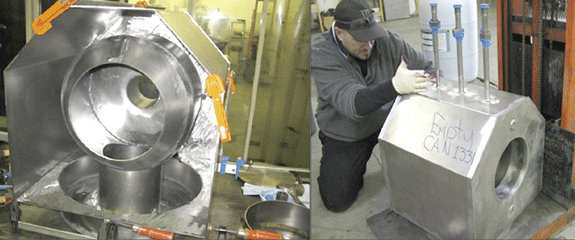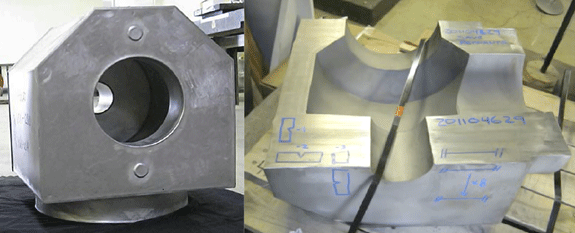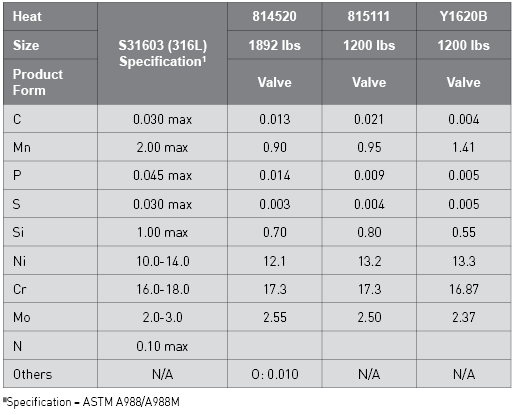Stainless steel PM HIPed nuclear valves
The International HIP committee (IHC) presented its ‘HIP Parts of Excellence’ award winners at HIP’14, the 11th International Conference on Hot Isostatic Pressing, Stockholm, Sweden, June 9-13. Electrical Power Research Institute received an award for its 316L stainless steel Powder Metallurgy HIPed nuclear valves.
The Electrical Power Research Institute (EPRI), USA, working with Synertech PM, Inc., Carpenter Powder Products, and Tyco Flow Control, manufactured 316L stainless steel PM HIP nuclear valves that were produced as part of a successful effort to establish ASME Boiler and Pressure Vessel Code Case N-834. The valve bodies were manufactured to Tyco Valve drawings and specifications allowing Tyco to independently and rigorously evaluate the manufactured valve bodies.
Large power generation components have traditionally been fabricated using established methods including: casting, rolling, drawing, forging, extrusion, and welding. HIP PM components have not been heavily used within the power generation community for three reasons. Firstly, within the US, materials and processes utilised to manufacture pressure retention or high-temperature power plant components are generally subject to the ASME Boiler and Pressure Vessel Code and no code existed for HIP PM materials.
Secondly, the size and shape of near-net shaped components have only recently reached a point comparable to forged/cast parts. In addition, the compositions/alloys that are of most interest to the industry have not been readily available.
Thirdly, the PM/HIP production route is generally perceived to be more expensive than traditional forging and casting routes. However, for stainless steels and nickel-based alloys, material systems where raw material costs are much higher, PM/HIP may offer a highly cost effective solution for specific applications.

Fig. 1 Images show the sheet metal capsule used to produce the 316L stainless steel valve bodies.The image on the left is an incomplete capsule in which the interior detail is visible. A complete capsule is being inspected on the right
The valves for this qualification project were made using a thin-wall capsule, HIP PM near net shape technique. Fig. 1 shows images of a HIP capsule in an intermediate and completed state. Fig. 2 shows the completed valve and that valve after sectioning. Combined, the two Figs illustrate how a sheet metal container can be fabricated such that internal chambers are produced as part of the process.

Fig. 2 Two images showing the as-HIPed 316L valve body (left) and the same valve body that has been sectioned in half as part of the evaluation performed in preparation of the ASME Code Case
Several advantages that HIP PM components offer the electric power industry were cited:
Inspectability
HIP PM components possess a uniform, homogenous microstructure that is very easy to inspect in terms of both detection and sizing offering the ability to detect extremely small flaw sizes for critical components.
Near-Net Shaped (NSS) components
Components produced with PM/HIP techniques can be produced very near final shape, resulting in reduced component weight, reduced machining, reduced energy consumption (such as in melting more material than required), and reduced waste from post-process machining.
Decreased machining/residual stress
Stainless steels and nickel base alloys work harden during machining. Work hardening not only increases the difficulty in machining, but can also induce residual stresses near the surface of a given component. Residual stresses drive known cracking mechanisms such as stress corrosion cracking in stainless steels for nuclear power applications.
New alloy systems and chemistries
Metal powder production is often a flexible process in that specific chemistries can be produced to an individual customer’s requirement, multiple powder heats can be blended to provide a near-exact chemistry and heats can be produced according to need, for example, ranging in size from hundreds to thousands of pounds.
Enhanced weldability
Cast components are often difficult to weld due to the many types of defects that can be present in the microstructure. Furthermore, castings and forgings typically result in very large grain sizes that can create additional issues in the welding and fabrication processes. The homogeneity and fine grain size of PM/HIP parts eliminates many of the conventional weldability issues inherent to either cast or forged components.
Alternate supply route / decreased delivery times
For some components long lead-times (of the order of two to five years) are commonly encountered in both the fossil and nuclear power generation sectors. The recent approval of PM/HIP technologies in the ASME BPV Code will allow utilities to source components from an alternate, PM HIP parts supplier. In a situation such as a forced outage due to component failure, the constraint is lead time as lost generation can be valued in the millions of dollars a day. Thus, even in situations where on a component basis PM-HIP may be more expensive, the improved lead time that PM HIP offers is desirable.
Elimination of rework or repair of large cast components
The ability to produce homogeneous microstructures via HIP PM substantially reduces the number of repairs required in castings. In discussions with various valve manufacturers, it is not uncommon for large cast components to require between 10 to 50% (by volume) repairs to eliminate casting defects.
Composition and mechanical property data for the 316L valves can be seen in Tables 1 and 2.

Table 2 Elevated temperature, tensile test results for one 316L stainless steel valve body manufactured during this project






